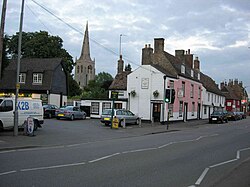Godmanchester
| Godmanchester | |
| Huntingdonshire | |
|---|---|
 Post Street in Godmanchester | |
| Location | |
| Grid reference: | TL245704 |
| Location: | 52°19’3"N, 0°10’21"W |
| Data | |
| Population: | 5,500 (2001) |
| Post town: | Huntingdon |
| Postcode: | PE29 |
| Dialling code: | 01480 |
| Local Government | |
| Council: | Huntingdonshire |
| Parliamentary constituency: |
Huntingdon |
Godmanchester is a small town in Huntingdonshire on the south bank of the River Great Ouse, south of Huntingdon. The centre of the town has a distinctive pattern, with roads set in a pentagon, on which shape the through roads converge. This pattern apparently dates from its Anglo-Saxon refoundation or earlier.
The town has two and many timber-framed Tudor houses, the largest being Tudor Farm, dating from 1600 and restored in 1995.
History
Godmanchester has an ancient origin. Its location is likely to have attracted attention due to the gravel beds providing a ford here across the River Great Ouse. Archaeology suggests Iron Age or earlier habitation, but certainly a Roman town was founded here with a mansio (an inn). The town was at a crossroads of two Roman roads; Ermine Street and a military road from Sandy, Bedfordshire. The town centre is rich in archaeological finds.
Godmanchester's name comes from its later position in the Anglo-Saxon period as Godmundceaster, meaning "Godmund's town", the word ceaster being particularly associated with old Roman places.
Original historical documents relating to Godmanchester, including the original church parish registers, local government records, maps, photographs and the surviving borough charters, are held at the County Record Office in Huntingdon.
Bridges and meadows

There are several bridges across the Great Ouse to Huntingdon, but until 1975 Old Bridge, Huntingdon, a mediæval bridge, was the only one. It is now used only for light traffic, and a parallel footbridge has been built for pedestrians. Construction of the A14 bypass means that heavy traffic now flows over a modern bridge.
One of the town's best-known features is the Chinese Bridge which connects Godmanchester with the water meadows of Portholme. The bridge was first built built in 1827 by the architect Gallier. Local legend has it that the Chinese Bridge was built without the use of nails or any other fixings. A number of years later, an architect applied to the council for permission to deconstruct the bridge to discover how exactly this had been accomplished. This being done, they tried to reconstruct it, but found that they could not get it to support itself under its own weight and it had to be nailed together. Whether the bridge was indeed built with pure carpentry and no nails may never be known for sure, but the bridge is of a remarkably beautiful, mathematical construction.
Today's Chinese Bridge however is not the original. In February 2010 the old bridge, which had become rotten and hazardous, was removed and replaced with a replaca.
Between Godmanchester, Huntingdon and Brampton lies Britain's largest meadow, Portholme [1], which remains an important flood plain. In past days it served as a horse race course and centre for early aviation. The meadow itself falls within the parish of Brampton.
Churches
- Church of England: St Mary The Virgin
- Baptist: Godmanchester Baptist Church
- Methodist: Huntingdon Methodist Church
- Society of Friends (Quakers): Rose & Crown Quaker Centre